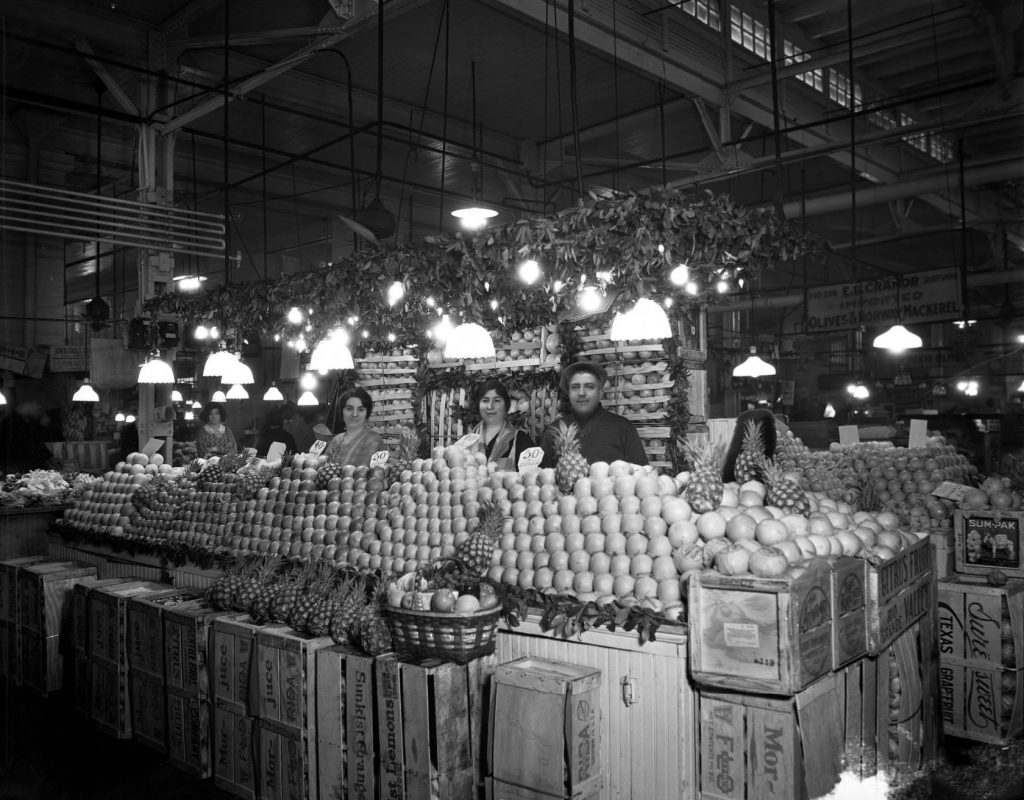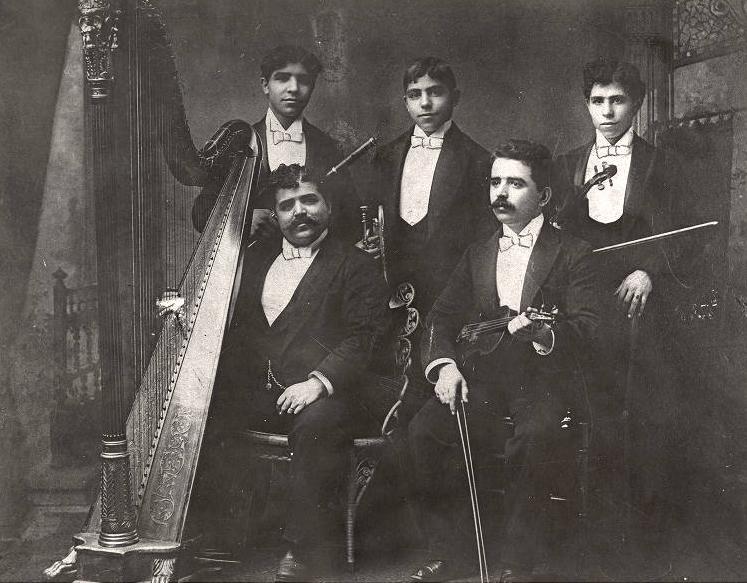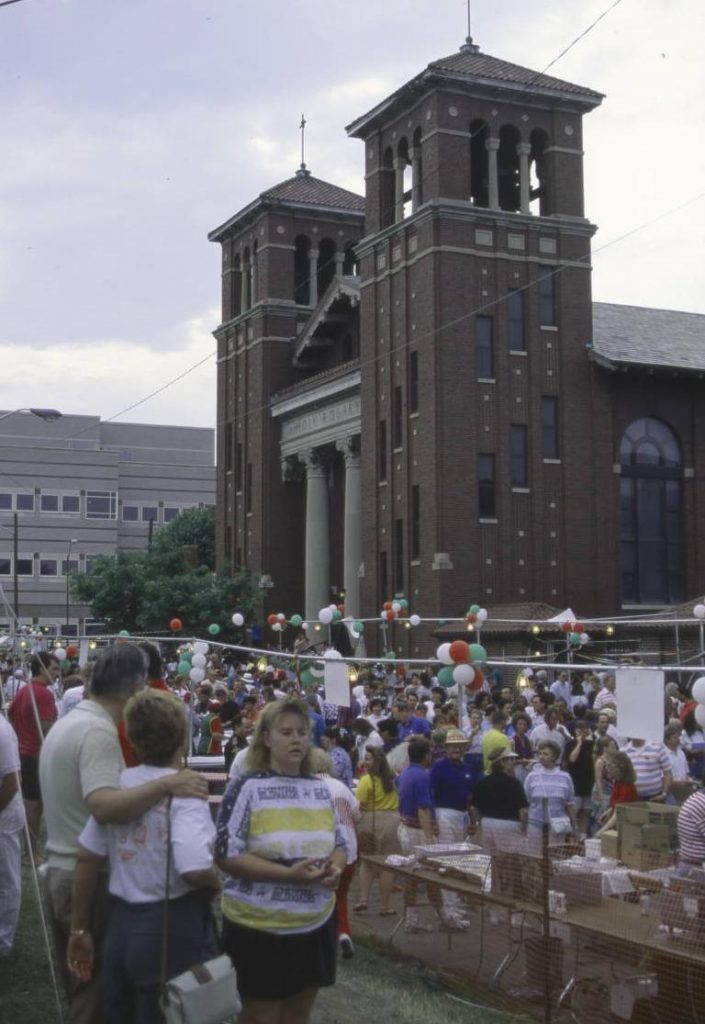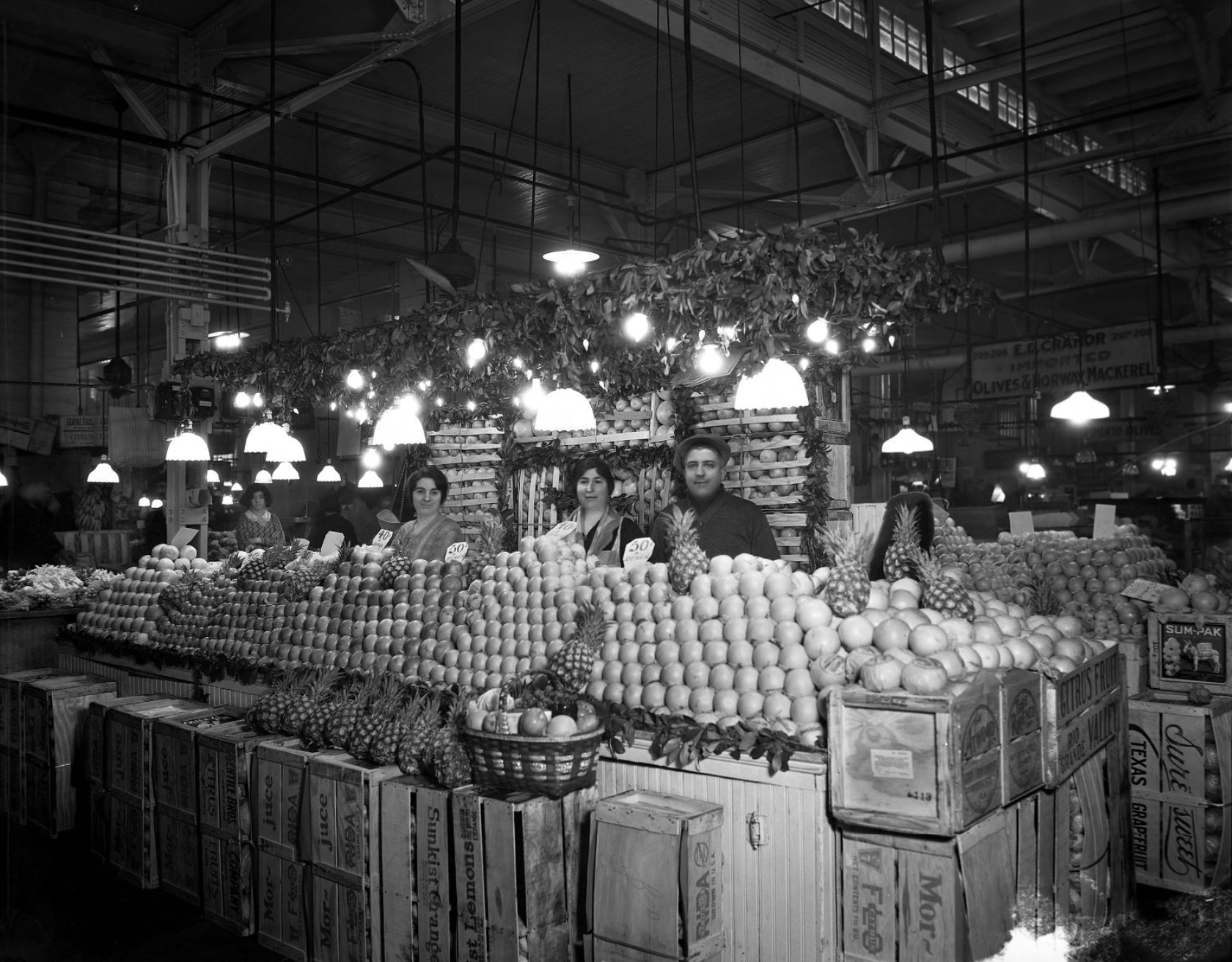By 1860, there were 19 Italian-born persons residing in Indianapolis. Over the next 50 years, the Italian population slowly grew to 1,137 (Sicilians comprised the largest single contingent), most of whom were employed in the food industry and the arts.

Italian fruit peddlers in the late 19th and early 20th centuries operated stands at busy intersections like Illinois and Washington streets, and several natives of Genoa ran a confectionery nearby. Frank Mascari from Termini Imerese opened a fruit store on Virginia Avenue near Washington Street in 1882 and was soon joined by several members of his family. By 1910, 33 of the city’s 54 fruit and vegetable dealers were Italian. They reputedly introduced the banana to the city, which earned several dealers the nickname “the banana kings.”
Italians were also prominent in the arts. The orchestra played for special events and at local parks in the early 1900s. Fresco painter Giovanni Gioscio, from Calvello in Basilicata, decorated local churches—notably old St. Joseph’s Catholic Church at College Avenue and North Street and prominent citizens’ homes.

Numbering over 2,000 by 1930, Italian immigrants and their children settled in the city by region of origin and employment. Sicilians in the produce business resided around the intersection of Virginia Avenue and South and East streets. Calabrians who worked for the gas or rubber companies lived along South College Avenue while those working for lived on the near northside. Neapolitan barbers and Calabrian shoemakers dispersed around the city. Friulan installers of terrazzo floors and marble artwork lived on the northeast side. Successful merchants and professionals in medicine and law resided on the north side. Despite these differences, the Italian community attempted to enhance its solidarity by organizing associations and clubs. The early ones provided social outlets and insurance: Umberto Primo (1891), Regina Margherita for women (1908), and Francesco Crispi for men (1918). Later organizations, like the Italian-American Society (1960s) and Sons of Italy (1974), were primarily social.

Religion was a key component of community life. Nominally Catholic, Italians attended German and Irish parishes until Methodists opened an Italian mission (1908-1920) around the Virginia Avenue-East Street triangle. In response, authorized Father to organize an Italian national parish called Holy Rosary (1909) in the Sicilian district on the southeast side. The parish school operated from 1911 to 1957. A brick and stone church, designed by Kopf and Wooling with bell towers modeled after Rome’s San Giorgio in Velabro, was constructed 1923-1925. A focus of the community’s social life, Holy Rosary Church attests to its faith and self-pride. In 1934, the church held its first Italian Street Festival. The event was created as a way to celebrate Italian heritage as well as attract membership and raise funds. The festival was brought back in 1984.
Economic advancement through self-employment was often an immigrant goal. Many Italians established produce firms, and in 1954, organized the Indianapolis Produce Terminal. Calabrian native Fred Iozzo opened the Garden of Italy, the first major downtown Italian restaurant, in the 1930s. Italian immigrants also worked to buy their own homes, and several amassed fortunes by investing in the deflated real estate market of the Great Depression. Their ordinary lifestyle was unostentatious; only at weddings and funerals was family wealth truly evident.
Politically, many Italians were Republican until the 1920s when support of Republican candidates led Italians to vote Democratic. Local Italians strongly supported American efforts in both world wars. In 1917-1918 they registered for military service, established a relief association to aid war victims, and participated in patriotic rallies. During the interwar period, many Italians supported Mussolini. They accepted his government’s gift of textbooks for local Italian language instruction (1932) and cheered his Ethiopian victory (1936). When Mussolini sided with Hitler, Indianapolis Italians proclaimed their support for the Allies as over 100 Holy Rosary men and women served in the U.S. armed forces. After 1945, the death of immigrant parents, economic improvement, and veterans establishing their own families elsewhere affected the cohesiveness of the Italian community. Many moved to southern Marion County or to the far northeast side. Holy Rosary Parish, with 1,011 members in 1950, reached a low point with 160 members in 1977.
In the years following World War II, new arrivals appeared alongside the old traditional families. One group was working professionals, transferred by their companies to Indianapolis, or doctors, lawyers, and teachers who found employment here. Usually, from large urban centers, they settled at the city’s northern outskirts and looked to the city for leisure and cultural pursuits. Recent immigrants who came as war brides or to pursue professional and middle-class occupations were a third element. They particularly treasured old-world traditions and language. These new elements brought a revived ethnic consciousness that coalesced around Holy Rosary Church and in the Columbus ’92 Commission.

In 1986 the listing of the on the National Register of Historic Places recognized the role of Italians and other immigrants in Indianapolis history. The commission, founded in 1989, planned appropriate observances of the quincentenary of the discovery of America including a gala dinner dance, Mass, and rededication of the Columbus bust on the State House grounds in October 1992. The commission subsequently reorganized as the Italian Heritage Society of Indiana.
In 1993, Mayor Steven Goldsmith collaborated with the Indianapolis Italian American community and Sister City Committee to establish a relationship with Monza, Italy that would lead to economic, educational, cultural, and motorsports-related exchanges with a city that is renowned for its Formula One race and strategically located in northern Italy in the urbanized territory of Milan. This partnership would lead to collaborations between Indianapolis and Monza institutions, organizations, universities, research centers, companies, schools, and citizens. The coalition behind the establishment of a sister city relationship grew to include leaders of the Italian Heritage Society, the Honorary Vice Consul of Italy, an Indianapolis city councilman, and civic and business leaders at and the . Upon establishment, the Indianapolis-Monza Sister City Committee collaborated with even more business leaders including (now Roche) and Indiana University Medical Center to provide opportunities for Indianapolis to continue developing the relationship through frequent visits with city leaders in Monza.
As a result of the Sister City alliance, the Italian presence in Indiana has continued to grow through the establishment of major industries in the automotive sector. In 2012 the Dallara IndyCar Factory, a joint venture between the Indy Car Experience and Dallara Automobili, opened at Indianapolis Motor Speedway. The 23,000-square-foot interactive hands-on exhibits centered on the engineering and technology of IndyCar race cars, as well as the history of Gian Paulo Dallara and his company, Dallara Automobili. In 2020 Fiat Chrysler Automobiles announced a $400 million investment in Kokomo that would create nearly 200 jobs and retail 1,000 more. Plans included repurposing an idled transmission plant into the Kokomo Engine Plant where the GMET4 engine would be produced.
The 2020 population estimates indicate close to a 30% drop in the Italian population since 2010, yet the descendants of Indianapolis’ earliest Italian entrepreneurs in the produce business continue to live and thrive in Indianapolis. Frank Mascari’s fruit store merged into Ray & Mascari. A relative of Frank Mascari, Joe Mascari formed Indianapolis Fruit in 1946 which in 1997 joined with Piazza Produce, established in the early 1970s under the umbrella organization IF & P which supplied produce to the food service and retail industry in 15 states. IF & P generated sales of $150 million at the time Indianapolis Fruit and Piazza Produce combined their efforts to distribute produce.

Help improve this entry
Contribute information, offer corrections, suggest images.
You can also recommend new entries related to this topic.
